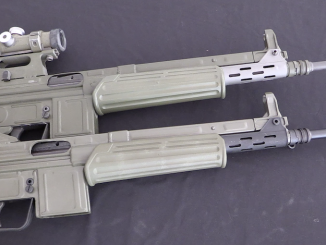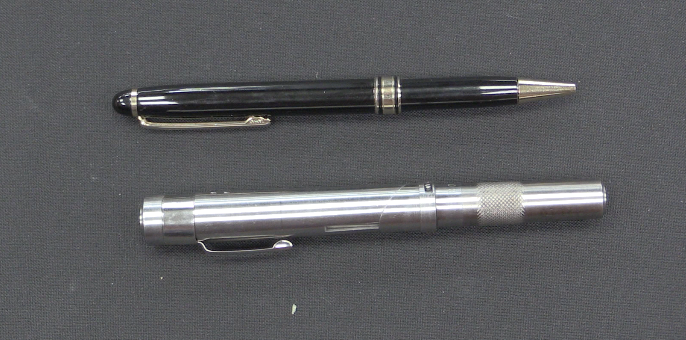Revolver: https://jamesdjulia.com/item/52428-2-397/
Holster: https://jamesdjulia.com/item/52458-1-397/
The Shawk & McLanahan revolvers are a lesser-known example of a very low production Civil War era revolver not made in the Confederacy. Abel Shawk was manufacturing entrepreneur in St Louis making fire engines when he decided to take up arms manufacturing instead. He partnered with J.K. McLanahan who acted as a financier for the project, and with a young German immigrant gunsmith named William (Anglicized from Wilhelm) Tegethoff.
Shawk apparently built his own rifling machine, and sourced many of his other tools form an acquaintance named Charles Rigdon. Ridgon would go on to move to the South and work on several revolver making enterprises for the Confederacy during the Civil War. This led to an assumption that the Shawk & McLanahan guns were also affiliated with the CSA, although they were actually not.
Only about 45 or 50 guns were made before the business venture fell apart, and the surviving examples are all slightly different, suggesting that a final production model was never perfected. The workmanship is quite good, though. The example we have today was actually plated and presented to a Confederate officer by his men, along with a very fancy metal holster.




Independent gun makers certainly did not last long without influential customers. Unless you struck it big and got investors along with lots of cash, you were doomed.
Weapon manufacturing might be, but don’t have to be firm single area of activity.
There are many examples, just to name few: Remington (typewriters), Husqvarna (motorcycles), Birmingham Small Arms Company (BSA, motorcycles).
So was FN, CZ, Suhl waffenfabrik and I believe also Izhevsk armory.
As rare as the Shawk and McLanahan revolver(s) might be, I currently own a weapon from same manufacturer that may be totally unique-one of a kind. It’s a .44 caliber repeating carbine produced circa 1860. The dealer I purchased the weapon from included provenance indicating that as of 1963 there were only three such pieces supposedly in existence. I say “supposedly” because the other two alleged carbines could not be independently varied to exist. They were very much in the ” I know someone who supposedly knows someone who has such a weapon”.
I’ve mailed the carbine to a representative at Morphy Auctions in Denver, Pa. with whom I’ve been in contact. He is currently doing further extensive research on the actual history of the Shawk McLananhan to determine if any other such weapons can be authenticated to still exist. Depending on his findings I may be placing the carbine up for auction in an upcoming fall 2018 auction on their website. I’m obviously very excited to learn of his findings.
I may be interested in purchasing the revolver.
Please let me know you price
“(…)Wilhelm(…)Tegethoff(…)”
Interesting coincidence with Admiral von Tegetthoff:
https://en.wikipedia.org/wiki/Wilhelm_von_Tegetthoff
though his name contain 3 t.
Carondelet ends in let, not the French styled lay. Although most of Missouri’s oldest settlements were founded by the French, given over to the Spanish, returned to the French, and bought by the Americans, they were largely populated by Germans. Nearly all of the French names and words in Missouri are bastardized in this way.
If you mean spelled (more or less) correctly, but mispronounced, you are pretty much on track. We here in St. Louis do say “Carondolet”, and tend to phoneticize a lot of “foreign” words.
Go an hour south to St. Genevieve and you will find a rich French tradition, as well as a lot more opportunities to mispronounce French words. Fortunately the natives are quite friendly 😉
CG
It would be a crying shame if the gun and holster were separated.
Wish me luck!
And, that’s Mary Chestnut’s husband!
Let’s see: revolver #1 is given as a gift to a Confederate general; the company was housed in Missouri, a slave state that was barely kept in the Union when the Civil War broke out; plus Rigdon, who “went South,” provided the machinery in some fashion. Seems absolutely reasonable to conclude the guns were Rebellion arms except for the winding up of the company before hostilities broke out. (And, I would add, their manufacturing quality.)
Are we sure Gen. Chestnut’s fellows bought rather than looted that gun? Or perhaps the original owner was a Missourian who had it on hand, went South with it, and turned it over as a gift? And where did Tegethoff go after Fort Sumter?
I am surprised the Union side did not discover and purchase the stock in their weapons-buying spree of the early years of the war.
Well, I dunno. Let’s see:
“Let’s see: revolver #1 is given as a gift to a Confederate general; the company was housed in Missouri, a slave state that was barely kept in the Union when the Civil War broke out; plus Rigdon, who “went South,” provided the machinery in some fashion. Seems absolutely reasonable to conclude the guns were Rebellion arms except for the winding up of the company before hostilities broke out. (And, I would add, their manufacturing quality.)”
Missouri was more than “barely kept in the Union”. While technically a slave state, there was strong and, in hindsight, unflagging support for the Union, especially in St. Louis, where secessionist sentiment never got further than a few spirited demonstrations and the odd skirmish between Federal troops and “militia”, which the Feds always won. Wilson’s Creek was a borderline victory for the Confederacy, to be sure, which was completely wasted by the usual inability of the southern forces to follow it up. Missouri’s large immigrant German population not only supported the Federal government, but enlisted in droves to fight both secession and slavery. If you believe Missouri was “barely kept in the Union”, you are going to be hard pressed to find a Confederate general or politician that would agree with that statement.
“Seems absolutely reasonable to conclude the guns were Rebellion arms except for the winding up of the company before hostilities broke out. (And, I would add, their manufacturing quality.)”
So every gun produced in Missouri in the years before the war was Confederate? I think the explanation that Colt’s patent ran out and some folks wanted to make some money (as was happening everywhere else at the same time) makes more sense.
“Are we sure Gen. Chestnut’s fellows bought rather than looted that gun? Or perhaps the original owner was a Missourian who had it on hand, went South with it, and turned it over as a gift?”
Who cares? The fact that this gun made it not only south, but 1500 miles east, in apparently excellent condition, indicates to me that these weapons were well dispersed long before the war – how long would it take to sell 50 good revolvers in a strong gun market like St. Louis, in ~1857?
“I am surprised the Union side did not discover and purchase the stock in their weapons-buying spree of the early years of the war.”
There was no stockpile to sell – by then these guns had been long sold, probably to either retailers in St. Louis (and there were dozens in those days), or to individuals, to recoup what could be had of the manufacturing costs. I am not aware of any record of the US Ordnance department buying any of these weapons.
CG
I remember in Louis Lamour’s ” To tame a land” his character used a shawk and mclanahan pistol and a joslyn carbine. Nice to see both on this site.
May 1957 episode 8 of tales of Wells Fargo featufesa shawk/mc clanahan pistol
I’m watching that Well’s Fargo episode right now.
with usual hype, thus time provided by brief comment by Hardee as to how rifle -like accurate and powerful it is. Ridiculous.
Interesting
Featured in Louis L’Amour’s book To Tame a Land.